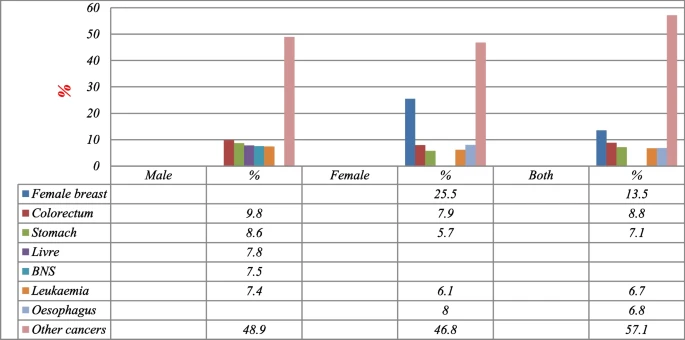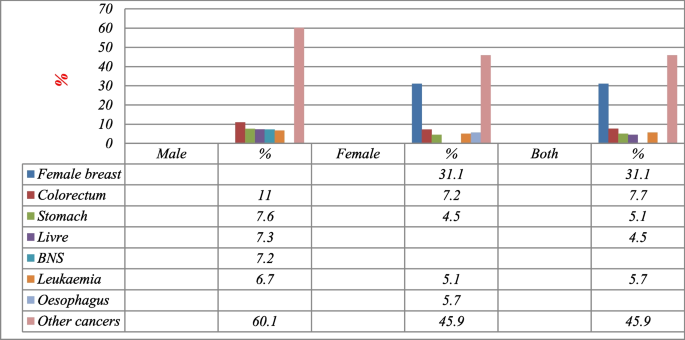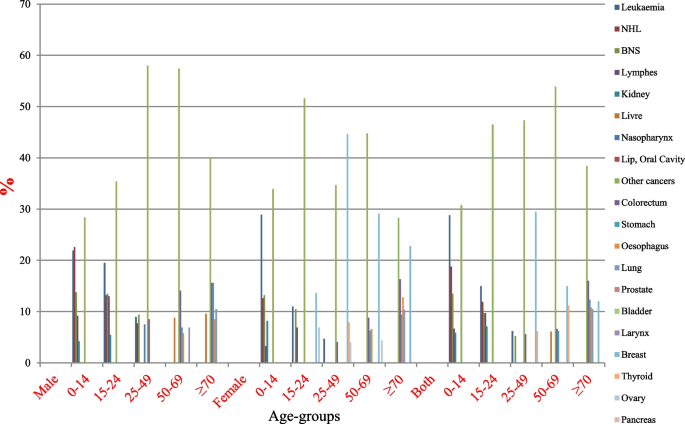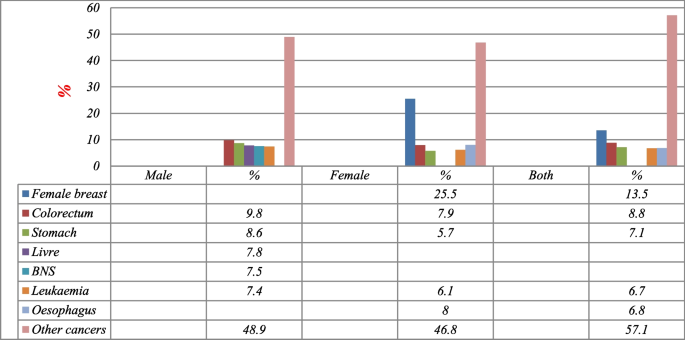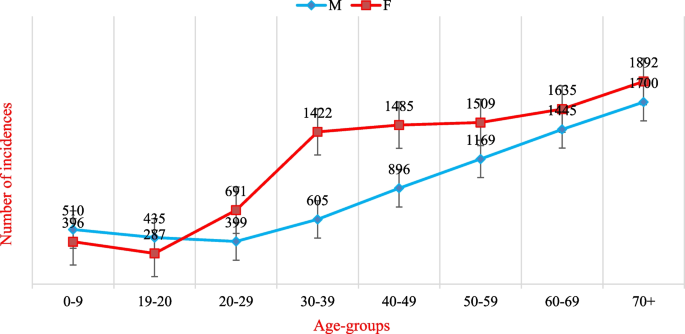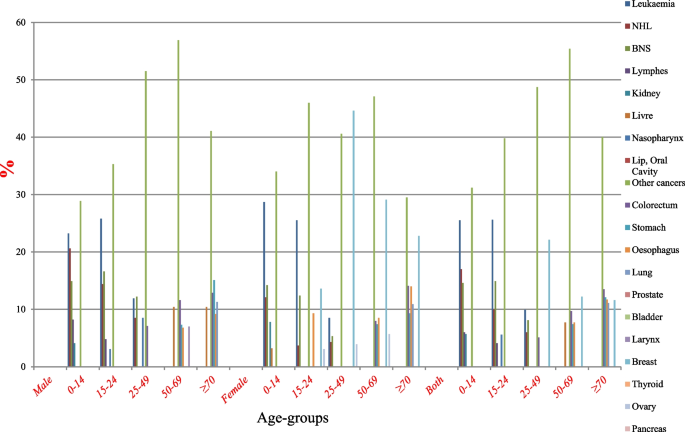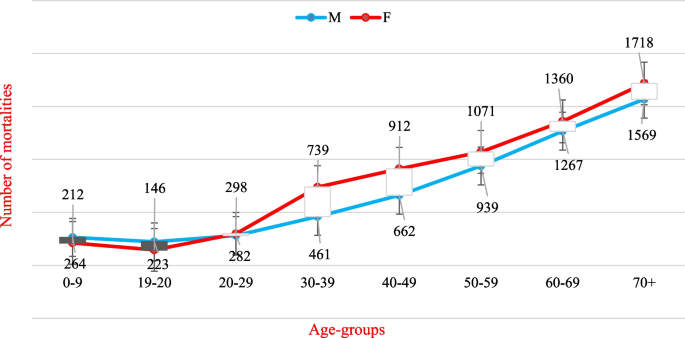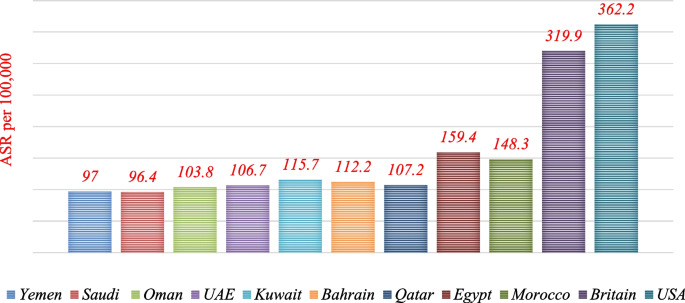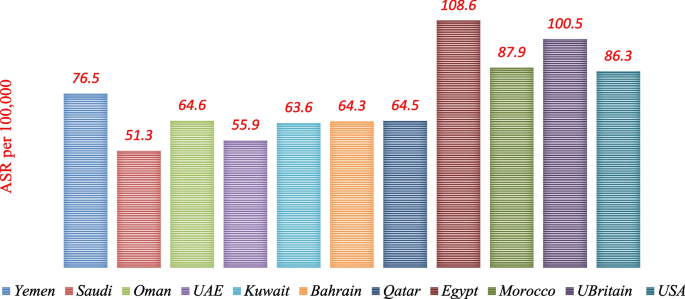Abstract
Background
The current cancer epidemiological profile in Yemen suffers from a lack of locally representative data and resources, posing a challenge in determining the real incidence, prevalence, survival and mortality rates, particularly data extracted from national hospitals. This study aims to provide a comprehensive overview of the cancer burden and trends in Yemen for 2020, including incidence and mortality rates.
Methods
The current study provides cancer statistics and their trends in Yemen, including incidence and mortality, in 2020 by using descriptive statistics. The data was obtained using the Global Cancer Observatory (GCO) 2020 online database.
Results
According to the (GCP) database in 2020, the crude incidence rate (CIR) of all cancers in Yemen was 55.2 per 100.000. The age-standardized rate (ASR) was 97.0 per 100.000, and the cumulative risk (0–74) was 22.0 per 100.000. The age-standardized rate (ASR) was 76.5 per 100.000, and the cumulative risk (0–74) was 19.6 per 100.000. Furthermore, the crude mortality rate (CIR) of all cancers was 40.6 per 100.000. Breast cancer was most prevalent in Yemen across all age groups and genders (31.1%), followed by colorectal cancer (7.7%) and leukemia (5.7%). Breast cancer also ranked as the primary cause of mortality at an estimated percentage of 13.5%, followed by colorectal cancer (8.8%) and stomach cancer (7.1%).
Conclusion
Cancer has become a significant life-threatening illness in Yemen with an increase in the disease burden of breast cancer in women. Furthermore, leukemia in children and colorectal cancer in both sexes have experienced a more significant burden as well. Therefore, it is imperative for initiatives for cancer control and prevention to be prioritised at national and regional levels.
Introduction
Cancer is becoming a big problem in developing countries as life expectancy rises [1]. Cancer surveillance is therefore critical for determining where progress is being achieved and where more needs to be done [2]. The global estimates of cancer are built up from estimates of incidence, prevalence, mortality, and survival in each of the national populations through Population-Based Cancer Registries (PBCR) [3]. Although data from Western countries are regularly included in International Association of Cancer Registries (IARC) publications on cancer incidence, this is not the case for Low- and Middle-Income Countries (LMIC), where the incidence is often estimated, due to the lack of high-quality data from existing Population-Based Cancer Registries (PBCR) [4]. Yemen is a developing country with a variety of meteorological, geographical, and environmental characteristics, and its regions are distinguished by distinct socioeconomic and genetic patterns [5]. Cancer is a significant public health problem in Yemen, and the size of the problem and underlying risk factors is not yet well studied [6]. The true epidemiological profile of cancer in Yemen is unknown due to limited resources for pathology, the scarcity, and quality of medical records, and limited epidemiology resources. On the other hand, war and civil conflict have recently been to the haziness of the national-level cancer burden. In the absence of national cancer surveillance, national cancer registries remain a main challenge in Yemen, as the country lacks a National Cancer Registries Centers [7]. Tobacco smoking is the single most important carcinogenic risk factor in Yemen, contributing to ~ 16.3% of cancers. Overall infections, Hepatitis B infection and obesity, and occupational risks is another important preventable cancer contributor which are responsible for ~ 13.4, 2.5% and, 1.4% respectively. Effective tobacco control policies, suggestions for healthier lifestyles, as well as expanding the coverage of successful screening, educating, and immunization programs, should all be included in comprehensive prevention and control strategies in Yemen in order to better sensitize greater awareness control to the general public. The updating of national cancer profiles and shedding more light on cancer risk factors would provide basic know hows on how to tackle it more effectively and can give scientific data for Yemen’s health policymaking [8,9,10].
Materials and methods
Data sources were extracted from the GLOBOCAN 2020 online database Cancer Today (https://gco.iarc.fr/today/home). GLOBOCAN estimates of the incidence, mortality, and prevalence of 36 cancer types in 185 countries or territories, categorized by sex and age group.
IARC’s approach is to evaluate, compile and use data provided by IARC collaborators in all countries of the world and also includes working alongside national staff to improve local data quality, record coverage and analytical capacity.
The estimation methods are specific to each country, and the quality of national estimates depends on the coverage, accuracy, and timeliness of recorded incidence and mortality data. The aim is to inform cancer control by improving the coverage, quality, and use of population-based cancer [11,12,13].
Statistical analysis
The incidence and mortality rates observed most recently at the national level were applied to the 2020 population. Rates were estimated by modelling national mortality data, using mortality-to-incidence ratios derived from the national cancer registries. National incidence and mortality rates for all cancers combined were obtained by averaging age- and sex-specific rates. These rates were then used to determine the incidence of specific cancer sites based on available cancer-specific relative frequency data. An age-standardized rate (ASR) is a weighted average of the age-specific rates, with the weights being based on the population distribution of a standard population. The age-standardized incidence or mortality rate (W) is the calculated rate expressed per 100.000person-years12. The crude incidence rate is calculated by dividing the total number of new cancer cases diagnosed in a specific year in the population category of interest by the at-risk population for that category, multiplying the result by 100.000. This rate is a useful measure for comparing cancer incidence across different populations. It is important to note that this rate does not take into account differences in age, sex, or other factors that may affect cancer incidence. A crude death rate equals the total number of cancer deaths during a specific year in the population category of interest, divided by the at-risk population for that category and multiplied by 100.000. Descriptive analysis was conducted on the extracted data, followed by comparisons and discussions. Due to the descriptive nature of the study, it was not possible to provide an accurate profile for the incidence and mortality of cancers in Yemen [11,12,13].
Results
Cancer incidence in Yemen during 2020
According to GLOBOCAN 2020 data statistics, the crude incidence rate (CIR) of all cancers was 55.2/100.000. The age-standardized rate (ASR) was 97.0/100.000, and the cumulative risk (0–74) was 22.0/100.000, (Table 1). Overall, it was registered 16,476 new cases distributed as follows: female breast (31.1%), colorectum (7.7%), leukaemia (5.7%), stomach (5.1%), non-Hodgkin lymphoma (4.5%), and other cancers (45.9%). Besides, breast cancer was ranked first in Yemen with ASR 30.5/100.000 population, followed by colorectum (10.7/100.000), leukaemia (4.2/100.000), stomach (7.1/100.000), Non-Hodgkin Lymphoma (4.0/100.000), oesophagus (6.4/100.000), BNS (3.8/100.000), lung (5.8/100.000), liver (5.1/100.000), Thyroid (1.9/100.000), hodgkin lymphoma (2.7/100.000), nasopharynx (1.7/100.000), pancreas (2.0/100.000), larynx (2.5/100.000), and ovary (2.2/100.000population) (Table 2 and Fig. 1).
Percentage of cancer incidence in all ages (both genders, males and females), Yemen, 2020. Data sources: https://gco.iarc.fr/today/home
In males, there were a total of 7159 new cases distributed as follows: colorectum (11.0%), stomach (7.6%), non-Hodgkin lymphoma (7.3%), leukaemia (7.2%), brain and central nervous system (6.7%), and other cancers (60.1%). In this group, the CIR of all cancers was 47.6/100.000, the ASR was 92.7/100.000, and the cumulative risk (0–74) was 23.2/100.000, (Table 2 and Fig. 1). Among the Yemeni population of males, colorectum cancer was ranked first in Yemen with ASR 12.0/100.000 population, followed by stomach (8.9/100.000), NHL (5.0/100.000), leukaemia (4.4/100.000), BNS (4.9/100.000), liver (7.1/100.000), lung (6.7/100.000), oesophagus (5.3/100.000), larynx (4.4/100.000), nasopharynx (3.0/100.000), hodgkin lymphoma (2.1/100.000), bladder (4.0/100.000), prostate (2.8/100.000), pancreas (2.5/100.000), and thyroid (1.5/100.000population) (Table 2 and Fig. 1).
In females, there were a total of 9317 new cases distributed as follows: breast cancer (31.1%), colorectum (7.7%), oesophagus (5.7%), leukaemia (5.1%), stomach (4.5%) and other cancers (45.9%). In this group, the CIR of all cancers was 62.9/100.000; the ASR was 102.2/100.000; and the cumulative risk (0–74) was 21.3/100.000. Among the Yemeni population of females, breast cancer was ranked first in Yemen with ASR 30.5/100.000population, followed by colorectum (9.5/100.000), oesophagus (7.2/100.000), leukaemia (4.0/100.000), stomach (5.7/100.000), thyroid (3.9/100.000), lung (5.1/100.000), NHL (3.2/100.000), ovary (3.4/100.000), BNS (2.9/100.000), liver (3.5/100.000), cervix uteri (2.5/100.000), pancreas (2.4/100.000), lip, oral cavity (1.8/100.000), and hodgkin lymphoma (1.2/100.000 population), (Table 2 and Fig. 1).
Tables 2 also show the common of the 15 cancers in both male and female genders, separately, the number of incidences, percentage, CIR, ASR, and cumulative rates (per 100.000) for all ages.
Cancer mortality in Yemen during 2020
According to GLOBOCAN 2020 data statistics, the CIR of all cancers was 40.6/100.000; the ASR was 76.5/100.000, and the cumulative risk (0–74) was 19.6/100.000, (Table 1 and Fig. 2). Overall, it was registered 12,103 new deaths distributed as follows: breast cancer (13.5%), colorectum (8.8%), stomach (7.1%), oesophagus (6.8%), leukaemia (6.7%), and other cancers (57.1%). Furthermore, breast cancer was ranked first in Yemen with ASR 18.9/100.000 population, followed by colorectum (7.7/100.000), stomach (6.4/100.000), oesophagus (6.2/100.000), leukaemia (3.6/100.000), lung (5.5/100.000), liver (5.0/100.000), BNS (3.5/100.000), NHL (3.0/100.000), nasopharynx, (1.7/100.000) pancreas (2.4/100.000), larynx (1.8/100.000), ovary (2.9/100.000), bladder (1.6/100.000), and lip, oral cavity (1.3/100.000 population) (Table 3 and Fig. 3).
The 5 common types of cancer death in males, female and both. Data sources: https://gco.iarc.fr/today/home
Percentage of cancer mortality in all ages (both genders, males and females), Yemen, 2020. Data sources: https://gco.iarc.fr/today/home
In males, there were a total of 5667 deaths distributed as follows: colorectum (9.8%), stomach (8.6%), liver (7.8%), BNS (7.5%), leukaemia (7.4%), and other cancers (58.9%). In this group, the CIR of all cancers was 37.7/100.000, the ASR was 77.9/100.000 and the cumulative risk (0–74) was 21.3/100.000. Among the Yemeni population of males, colorectum cancer was ranked first in Yemen with ASR 8.6/100.000 population, followed by stomach (8.0/100.000), liver (7.0/100.000), BNS (4.7/100.000), leukaemia (3.8/100.000), lung (6.5/100.000), NHL (3.9/100.000), oesophagus (5.2/100.000), larynx (3.8/100.000), nasopharynx (2.6/100.000), bladder (2.9/100.000), pancreas (2.4/100.000), hodgkin hymphoma (1.3/100.000), prostate (1.7/100.000), and lip, oral cavity (1.1/100.000 population) (Table 3 and Fig. 3).
In females, there were a total of 6436 new deaths distributed as follows: breast (25.5%), oesophagus 516 (8%), colorectum (7.9%), leukaemia (6.1%), 370 (5.7%), other cancers (46.8%). In this group, the crude mortality rates (CIR) of all cancers was 43.5/100.000, the ASR was 76.1/100.000, and the cumulative risk (0–74) was 18.5/100.000. among the Yemeni population of females, breast cancer was ranked first in Yemen with ASR 18.9/100.000 population, followed by colorectum (7.0/100.000), oesophagus (6.9/100.000), leukaemia (3.4/100.000), stomach (5.1/100.000), lung (4.8/100.000), liver (3.4/100.000), BNS (2.5/100.000), ovary (2.9/100.000), NHL (2.2/100.000), pancreas (2.4/100.000), cervix uteri (1.8/100.000), lip, oral cavity (1.4/100.000), thyroid (1.3/100.000) and nasopharynx (0.87/100.000population), (Table 3 and Fig. 3).
Age specific in cancer incidence and mortality
ASR (age-standardised rate); incidence
Categories were created for 5 age intervals spanning childhood and adulthood: ages < 15 years, ages 15–24 years, ages 25–49 years, ages 50–69 years, ages ≥70 years. As a result, each age-group cohort demonstrated some characteristics in the most frequent type of cancer, with similarities and variances between males and females.
Overall, leukaemia was the most common type of cancer in children and teenagers aged < 25 years with a rate of (24.8–15.0%) respectively and female breast cancer was the most incidence common in the two cohorts aged (25–49) and (50–69) years with a rate of (29.9–15.9%). In the cohort belonging to the elderly cohort aged ≥70 years colon cancer was the most common type of cancer with a rate of (16.0%) (Fig. 4).
The 5 common types of cancer incidence in males, female and both. Data sources: https://gco.iarc.fr/today/home
In males, NHL and leukaemia were the most common type of cancer in children aged < 15 years with a rate of (22.6–21.9% respectively) and leukaemia cancer also was the most incidence common in the teenagers 15–24 years of age with a rate of (19.9%). While BNS was the most incidence common in the cohort belonging to the 25–49 year group. While colorectal cancer was the most incidences common type of cancer in the cohorts aged (50–69) years with a rate of (14.1%). In the cohort belonging to the elderly cohort aged ≥70 years stomach and colorectal cancer was the most incidence common with a rate of (15.6% for both) (Fig. 4).
In females, leukaemia was the most common type of cancer in children aged < 15 years with a rate of (28.9%) and breast cancer was the most common type of cancer in the other three age-cohorts (15–24, 25–49, and 50–69) with a rate of (13.6%), 44.6 and 29.1% respectively). While in the cohort belonging to the elderly cohort aged ≥70 years breast also and colorectal cancer were the most common type of cancer with a rate of (22.8 and 16.3% respectively) (Fig. 4).
Figure 5 indicates that the incidence of cancer grows with age in both sexes, with males having a greater incidence rate than females in the childhood category. But was then surpassed by higher incidences in females, especially in those age groups (30–50 years). This can be explained by the high incidence of breast cancer among females, and then the incidence rates for both sexes continue to grow in those over 60 years of age and over for both sexes, with light raise in incidence rates among females.
The number of cancer cases with age among Yemeni males and females. Data sources: https://gco.iarc.fr/today/home
ASR (age-standardised rate); mortality
Five taxonomic categories were used to gain better knowledge of the most common cancers deaths by sex: children < 15 years of age; adolescents and adolescents between the ages of 15 and 24; young people from 25 to 49 years old; adults 50–69 years old; and the elderly ≥70 years old. As a result, each age-group cohort demonstrated some characteristics in the most frequent type of cancer, with similarities and variances between males and females.
Overall, leukaemia was the deadliest common type of cancer in children and teenagers aged < 25 years with a rate of (25.6–25.5%) respectively and female breast cancer was the deadliest common type of cancer in the two cohorts aged (25–49 and 50–69) years with a rate of (22.1–22.2%), While in the cohort belonging to the elderly cohort aged ≥70 years colorectal cancer was the deadliest common with a rate of (13.5%) (Fig. 2).
In males, NHL and leukaemia were the deadliest common type of cancer in children aged < 15 years with a rate of (23.2–20.6%, respectively) and leukaemia cancer also was the deadliest common in teenagers (15–24) years of age with a rate of (25.8%). While BNS and leukaemia cancer were the most death common in the cohort belonging to the (25–49) year group with a rate of (12.2 and 11.9%, respectively) and colorectal and liver cancer were the deadliest common type of cancer in the cohorts aged (50–69) years with a rate of (11.6 and 10.4%, respectively). In the cohort belonging to the elderly cohort aged ≥70 years stomach and colorectal cancer was the deadliest common with a rate of (15.1 and 12.9% for, respectively) (Fig. 2).
In females, Leukaemia was the deadliest common type of cancer in children and teenagers aged < 25 years with a rate of (28.7% and 25.5, respectively). While breast cancer was the deadliest common type of cancer in the two age-cohorts (25–49 and 50–69) with a rate of ((37.4%) and (23.2%)), respectively). While in the cohort belonging to the elderly cohort aged ≥70 years breast also, colorectal, and oesophagus cancer were the deadliest common type of cancer with a rate of (22.2, 14.1, and 14.0% respectively) (Fig. 2).
Figure 6 indicates that the death of cancer grows with age in both sexes, with males having a little greater death rate than females in the childhood category. But was then surpassed by higher deaths in females, especially in those age groups (30–60 years). This can be explained by the high death of breast cancer among females, and then the death rates for both sexes continue to grow in those over 60 years of age and over for both sexes, with light raise in death rates among females.
The number of cancer deaths with age among Yemeni males and females. Data sources: https://gco.iarc.fr/today/home
Tables 3 also show the common of the 10 cancers in both male and female genders, separately, the number of deaths, percentage, CIR, ASR, and Cumulative Rates (per 100.000) for all ages.
Discussion
Annual cancer statistics surveillance is critical for determining where progress is being achieved and where more needs to be done [2]. Cancer-control initiatives are having an effect on Yemen’s cancer burden. However, cancer remains a growing burden on the Yemeni healthcare system, with an annual increase in the total number of new primary cancers expected, owing in large part to population growth and age [7]. In this paper, we reported the overview of cancer burden and their trends in Yemen, including incidence and mortality, in 2020 using GLOBOCAN 2020 online data source. There were 16,476 cases and 12,103 deaths registered among both genders of all ages.
Overall, cancer cases were more among females than males. Comparisons showed that cases of breast cancer were dominant among females in Oman, Saudi Arabia, Egypt, Morocco, Britain, and America, with estimates of (37.7%), (29%), (32.4%) (38.9%), (25.5%), and (24%), respectively by the GLOBOCAN 2020 database. While there were some differences in dominant cases among males, colorectal was dominant in Oman and Saudi Arabia, (12.9%), (19.3%) respectively, liver (27.3%) in Egypt, lung (22.3%) in Morocco, prostate in Britain and America; (23.1%), (17.1%), respectively [1, 5, 6, 14].
Contrary to data indicating that lung and colorectal cancer are the most frequent types of cancer in high-income nations and the Gulf of Bahrain, it is surprising that the incidence of lung cancer is not highly reported in the GLOBOCAN 2020 database. This might be the result of Yemenis having a reduced life expectancy and poor lung cancer diagnosis, with a focus on tuberculosis rather than lung cancer [3, 11, 15]. But according to the most recent world health organization (WHO) report on the global tobacco epidemic, published in 2017, Yemen’s prevalence rate of tobacco use has climbed by 18.7%, contributing to ~ 16.3% of cancers. Smoking in the nation is frequently connected to locally utilized leaves called Khat (Catha edulis), which may cause lung cancer rates to rise in the future [16, 17].
The range of ASR among the 15 most common cancer sites in males ranged from (12.0/100.000 population) for colorectum cancer to (1.5/100.000 population) for thyroid cancer, while in females it was between (30.5/100.000 population) for breast cancer and (1.2/100.000 population) for hodgkin lymphoma cancer. Although female breast cancer was the most common cancer in Yemen, the rate was the lowest compared with the selected world countries. Moreover, the ASR of breast cancer in Yemen was three times lower than in the United States of America cancer (90.3/100.000 vs. 30.5/100.000). Similarly, colorectal cancer in males was three times lower than in the United Kingdom of Britain (34.1/100.000 vs. 10.7/100.000) [18]. The population in the chosen countries with higher rates of cancer incidence probably goes through some kind of screening and early detection for cancer, which is missing in Yemen. Furthermore, primary healthcare services in Yemeni ministry of health areas are not comparable to those in selected countries where basic screening methods for breast cancer, prostate cancer, and colorectal cancer are practiced on a daily basis [19]. Comparisons showed that the ASR incidence rate of different types of cancers (per 100.000 population) in Yemen is less or equal to data in some selected countries in the Middle East and others (Fig. 7). This is of course due to the fact that the reported cases in Yemen do not correspond to an actual number of cases. In addition to the misdiagnosis of some cancerous tumors, the discovery of cancer in very late stages, the scarcity of epidemiological and statistical studies, limited resources for pathology, and the scarcity of medical registries. On the hand, some national studies showed lower rates than GLOBOCAN estimates for 2020 [1, 5, 14, 18].
Comparing the ASR (World) per 100,000 for incidence, both sexes, and all ages in Yemen with some international rates. Data sources: https://gco.iarc.fr/today/home
With comparing the proportion rates of similar types of cancers between females and males except for breast cancer, which is sex-specific and dominant in females, in the age group (0–14) females showed higher rates of leukemia cancers compared with males (28.9% females) vs. (21.9% males), while in age groups (15–24 and 25–49) males showed higher rates of leukemia and BNS compared with females (19.5 and 13.5% males) vs. 11 and 10.5% females) respectively, and also in the age group 50–69 males showed higher rates of colorectal compared with females (14.1% males) vs. (8.8% females) (Fig. 4). Surprisingly, through the distribution of cancers in the children’s age groups in both genders, childhood cancer is leukemia, which corresponds to the most prevalent cancers in Yemeni childhood reported in prior studies, with leukaemia being the most common, followed by lymphoma and central nervous system tumors (Fig. 2) [3, 6, 20]. Except for breast cancer in females, which is the most frequent in many world countries, data from other Middle Eastern countries, such as Saudi Arabia, Jordan, Morocco, and Egypt, show patterns of cancer incidence that differ from data from Yemen [21,22,23,24,25].
According to the age groups in both sexes, Leukaemia was the most common type of cancer in children and teenagers aged < 25 years with a rate of (24.8–15.0%) respectively and female breast cancer was the most incidence common in the two cohorts aged (25–49) and (50–69) years with a rate of (29.9–15.9%). In the cohort belonging to the elderly cohort aged ≥70 years colon cancer was the most common type of cancer with a rate of (16.0%). The data not only emphasize the population’s cancer burden as a health priority, but also emphasize the importance of understanding variations over time and that there may be minor differences in rankings between areas within the same country and city as a result of lifestyle, population quality of life and behavioral risk factors, and different environmental exposures.
Figure 5 indicates that the incidence of cancer grows with age in both sexes, with males having a greater incidence rate than females in the childhood category. But was then surpassed by higher incidences in females, especially in those age groups (30–50 years). This can be explained by the high incidence of breast cancer among females, and then the incidence rates for both sexes continue to grow in those over 60 years of age and over for both sexes, with light raise in incidence rates among females. According to El-Zaemey (2012) of the National Oncology Centre in Sana’a, Yemen, roughly 71% of women diagnosed with breast cancer were 50 or younger. In the same context [26], other studies have addressed the involvement of reproductive factors in the development of breast cancer, such as prolonged oestrogen exposure, early menarche, late menopause, and others [19, 27, 28]; however, these factors were not studied in Yemen.
It is difficult to determine the specific mortality rates for cancer, especially for those coming from remote areas of Yemen. Thus, it becomes difficult for them to access the healthcare centers in the country’s main cities [11, 29].
Overall, cancer deaths were more among females than males. Comparisons showed that death from breast cancer was dominant among females in Oman, Saudi Arabia, and Morocco, with (37.7%), (29%), and (24.7%), respectively, while liver (22.9%) in Egypt, lung in Britain and America (20.8%), (22.5%), respectively by data 2020. While among males, colorectal was dominant in Oman and Saudi Arabia, (11.9%) and (15.8%) respectively, liver (35.6%) in Egypt, lung in Morocco, Britain, and America (28.5%), (22.7%), and (22.7%), respectively [11].
Comparisons showed that the ASR mortality rate of different types of cancers (per 100.000populations) in Yemen is less or equal to data in some selected countries in the Middle East and others (Fig. 8). It is difficult to determine the precise mortality rates for cancer, especially for those coming from remote regions of Yemen. That is due to the fact that the reported cases in Yemen do not correspond to an actual number of cases. In addition to the misdiagnosis of some diseases as the fact of death and the “underlying” cause of death is not established, the discovery of cancer in very late stages, the scarcity of epidemiological and statistical studies, limited resources for pathology, and the scarcity of medical registries. On the hand, some national studies showed lower rates than GLOBOCAN estimates for 2020.
Comparing the ASR (World) per 100,000 for mortality, both sexes, and all ages in Yemen with some international rates. Data sources: https://gco.iarc.fr/today/home
With comparing the deadliest common type of cancer between females and males except for breast cancer, which is sex-specific and dominant in females in the cohort belonging to (25–49 and 50–69), leukaemia was the deadliest common type of cancer in the cohort belonging to (0–24) with a rate of (28.7% females) vs. (23.2% males), while in the cohort belonging to the elderly cohort aged ≥70 years colorectal cancer was the deadliest common with a ratio of (22.2%) among females compared with stomach cancer with a ratio of (15.1%) among males (Fig. 2) [3, 20]. However, no significant differences in cancer death were seen between males and females. Data from other Middle Eastern countries, such as Saudi Arabia, Jordan, Morocco, and Egypt, show patterns of cancer death that agree with the data from Yemen [21, 22, 24, 30, 31].
It has been clearly established that developing countries, such as Yemen, have low accuracy in determining the underlying cause of death, compared to high accuracy in developed countries. Furthermore, many nations in the Eastern Mediterranean Region and North Africa lacked the financial and technological resources needed to collect high-quality, complete, and timely data on mortality [32,33,34,35]. However, using death certificates and estimating cancer-related death rates may be a crucial step in extrapolating Yemen’s cancer mortality in order to activate the existing comprehensive national cancer control program, which includes an active role in cancer surveillance, and integrate it into the country’s existing healthcare system. Unfortunately, full data on cancer incidence and death for the entire country are not yet accessible because the Ministry of Health in Yemen’s registries are only partially operational due to a lack of technical and financial support. However, estimating Yemen’s cancer profile might be conceivable if GLOBOCAN 2020 data were utilized to extrapolate Yemen’s cancer mortality and incidence.
It is important to note that: Five population-based cancer registries were established in Yemen to collect, operate, and evaluate data on cancer patients. These include the Aden Cancer Registry (ACR), overseen by Aden University and accepted by the International Association of Cancer Registries in 1998, and the National Oncology Center in Sana’a, which is administratively affiliated with the National Cancer Foundation (NCCF). The Yemen Cancer Registry (YCR) was established in 2003 and has branches in several provinces. Additionally, there are three other registries: the Hadhramaut Cancer Registry in Al-Mukalla City, the Hadramout Valley and Desert Oncology Center (HVDOC), and the Taiz Cancer Registry (administratively affiliated with the Ministry of Public Health and Population). However, the final three registries only serve as hospital registries.
It is also important to mention the cancer risk factors in Yemen in this aryical. Limited research has been conducted on cancer risk factors in Yemen. Only one study has explored breast cancer risk factors, which identified several primary risk factors among Yemeni women. These include being divorced, never having breastfed a child, using oral contraceptives, hypertension, having a family history of malignancy, and postmenopausal status. Another study used data mining techniques to investigate cancer risk factors. The study results indicate that smoking, chewing tobacco (Shamaa), age, marital status, and place of residence are the most significant risk factors for developing cancer. Another study focused on gastric cancer risk factors found that living in rural areas, tobacco chewing (Shamma), and drinking untreated water are the main contributors to this disease. Various studies have been conducted on public awareness and knowledge of cancer risk factors, including breast, oral, lung and other cancers. References suggest that in Yemen, the primary risk factors for cancer are tobacco use (16.3%), overall infections (13.4%), Hepatitis B infection, obesity (2.5%), and occupational hazards (1.4%) [9, 10, 36].
Conclusions
Population growth and aging, together with lower infectious disease mortality, lifestyle, and different environmental exposures, could explain why cancer incidence has grown globally. Cancer is becoming a big problem in developing countries mainly due to life expectancy rises, and a growing, and aging population too [7, 37, 38]. The cancer registries in LMIC, often struggle with lack of funding and incomplete or inaccurate data. In addition, many countries in Eastern Mediterranean Region and North Africa were lacked financial or technical resources to collect good quality, complete and timely data [32,33,34]. The exact cancer incidence and mortality in Yemen is unknown, often hidden and diagnosed in late stages due to limited resources for pathology, the scarcity and quality of medical records, absence of early diagnostic devices, and limited epidemiology resources. There aren’t enough Yemeni national statistics on cancer, and information on cancer patterns is still very limited [6, 39, 40].
Estimates show areas where more work is required. Currently, no screening tests are available for primary cancers except female breast cancer. Greater efforts are required to improve primary prevention, early detection, and treatment for major cancers, particularly with the introduction of technical advancements in the management of these advanced tumors since the 1990s, as alternatives for detection and treatment remain so limited. To further lessen the effects of cancer on individuals in Yemen, more support and funding must be provided for creative research projects and healthy, effective public policies that are implemented across the spectrum of cancer prevention.
There are a few limitations to this study. Due to the descriptive character of the study; this could not give real profile for further rate of cancer in the Yemen. The IARC GLOBOCAN-Yemen-2020 estimates for incidence and mortality of cancer were derived from data available from the national cancer registries.
Estimates indicate that cancer has a substantial effect on the Yemeni population. There is a critical imperative for enhanced public education and training to bridge the expanding knowledge gap between evidence-based cancer prevention and the reduction of established risk factors. It is crucial to establish effective policies for controlling known risk factors and to prioritise healthy lifestyles. Moreover, there is a need to broaden the reach of successful screening, awareness-raising, and vaccination programmes. Ultimately, prevention is preferable to treatment.
Availability of data and materials
All data generated or analyzed during this study are available in the GLOBCAN 2020 online database (gco.iarc.fr) or in the referenced published articles.
References
-
The National Oncology Program: A Yemeni-Canadian partnership. https://www.sciencedirect.com/science/article/pii/S1658387609500416.
-
Brenner DR, Poirier A, Woods RR, et al. Projected estimates of cancer in Canada in 2022. Cmaj. 2022;194(17):E601–7. https://doi.org/10.1503/CMAJ.212097.
-
Bawazir AA. Cancer incidence in Yemen from 1997 to 2011 : a report from the Aden cancer registry. Published online 2018:1–10.
-
Allen H, Driedger A, Fournie K, Basahi M. Canadian partnership. Hematol Stem Cell Ther. 2009;2(1):294–8. https://doi.org/10.1016/S1658-3876(09)50041-6.
-
Cancer registration data and quality indicators in low and middle income countries: their interpretation and potential use for the improvement of cancer care. https://doi.org/10.1007/s10552-008-9288-5.
-
WB. World Bank Country and Lending Groups. World Bank Data: World Bank; 2020. https://www.worldbank.org/en/where-we-work. Accessed 5 Dec 2020.
-
Cancer in the Arab World. https://library.oapen.org/handle/20.500.12657/54044
-
Nasher AT, Al-Hebshi NN, Al-Moayad EE, Suleiman AM. Viral infection and oral habits as risk factors for oral squamous cell carcinoma in Yemen: a case-control study. Oral Surg Oral Med Oral Pathol Oral Radiol. 2014;118(5):566–572.e1. https://doi.org/10.1016/j.oooo.2014.08.005.
-
Al-Maweri SA, Addas A, Tarakji B, et al. Public awareness and knowledge of oral cancer in Yemen. Asian Pacific J Cancer Prev. 2014;15(24):10861–5. https://doi.org/10.7314/APJCP.2014.15.24.10861.
-
Al-Hashedi A, Sallam AA, Mohsen AM. Exploring Cancer Risk Factors using Data Mining Techniques: A Case Study from Yemen. J Sci Technol. 2018;23(2):1–30. https://doi.org/10.20428/jst.v23i2.1429.
-
Cancer Today. WHO. https://gco.iarc.fr/today/home.
-
Cancer Today. Data & Methods. Accessed by 01/01/2024. https://gco.iarc.fr/today/data-sources-methods.
-
Understanding Cancer Incidence and Mortality Rates Accessed by 5/1/2024. https://www.dhs.wisconsin.gov/wish/cancer/understanding.htm
-
Cancer incidence in Yemen from 1997 to 2011: a report from the Aden cancer registry. 10.1186/s12885-018-4411-9.
-
Cancer incidence and mortality worldwide: sources, methods and major patterns in GLOBOCAN 2012. https://pubmed.ncbi.nlm.nih.gov/25220842/.
-
Prevalence of Cigarette Smoking and Khat Chewing Among Aden University Medical Students and Their Relationship To Bp and Body Mass Index. https://journals.lww.com/sjkd/Fulltext/2009/20050/Prevalence_of_Cigarette_Smoking_and_Khat_Chewing.28.aspx.
-
Marway R. Oral health: the destructive effects of khat. Br Dent J. 2016;221(1):2. https://doi.org/10.1038/sj.bdj.2016.468.
-
Cancer Trends in England and Wales 1950-1999. https://link.springer.com/book/9780116213938.
-
Bawazir A, Bashateh N, Jradi H, Bin BA. Breast Cancer screening awareness and practices among women attending primary health care centers in the Ghail Bawazir District of Yemen. Clin Breast Cancer. 2019;19(1):e20–9. https://doi.org/10.1016/j.clbc.2018.09.005.
-
Childhood cancer in Aden, Yemen. https://www.sciencedirect.com/science/article/abs/pii/S1877782113001604.
-
Childhood cancer hospital resource utilization and costs in Egypt, 2013–2017; patterns, trends, and associated factors for 8886 patients from Children’s Cancer Hospital, Egypt. 10.1002/pbc.29347.
-
Cancer in Saudi Arabia. https://www.annsaudimed.net/doi/full/10.5144/0256-4947.1989.55.
-
Repurposing “old” blood tests to replace costly interim analysis/imaging of Hodgkin lymphoma in low and middle-income settings. https://research-repository.st-andrews.ac.uk/handle/10023/26209.
-
Tracking cancer in Morocco: A systematic review. https://www.researchgate.net/profile/Abderrahmane-Achbani/publication/359402541_Tracking_cancer_in_Morocco_A_systematic_review/links/623a3509adf1e863369c424d/Tracking-cancer-in-Morocco-A-systematic-review.pdf.
-
Global, regional, and national life expectancy, all-cause mortality, and cause-specific mortality for 249 causes of death, 1980–2015: a systematic analysis for the Global Burden of Disease Study 2015. https://www.thelancet.com/journals/lancet/article/PIIS0140-6736(16)31012-1/fulltext.
-
El-Zaemey S, Nagi N, Fritschi L, Heyworth J. Breast cancer among Yemeni women using the National Oncology Centre Registry 2004-2010. Cancer Epidemiol. 2012;36(3):249–53. https://doi.org/10.1016/j.canep.2012.01.006.
-
Reproductive factors and postmenopausal hormone use in relation to endometrial cancer risk in the Nurses’ Health Study cohort 1976–2004. 10.1002/ijc.24672.
-
Estrogen Effects on the Mammary Gland in Early and Late Life and Breast Cancer Risk. https://pubmed.ncbi.nlm.nih.gov/28603694/.
-
Endometrial Cancer Trends in England and Wales: A Possible Protective Effect of Oral Contraception. https://academic.oup.com/ije/article-abstract/19/2/255/708413.
-
Blood P, Al-halbouni L, Amarin JZ. PO0219 / # 1635 Incidence of Childhood Cancer in Jordan , 2000–2017. 2021;(October):1–3. 10.1002/pbc.29349
-
Collaborators D. Global , regional , and national life expectancy , all-cause mortality , and cause-specifi c mortality for 249 causes of death , 1980–2015 : a systematic analysis for the Global Burden of Disease Study 2015. Published online 2017:1980–2015. 10.1016/S0140-6736(16)31012-1.
-
New data tells us more about cancer incidence in North Africa. https://www.sciencedirect.com/science/article/abs/pii/S0959804909008661.
-
Cancer magnitude, challenges and control in the Eastern Mediterranean Region. https://apps.who.int/iris/handle/10665/117400.
-
Use of health systems evidence by policymakers in eastern mediterranean countries: views, practices, and contextual influences. https://bmchealthservres.biomedcentral.com/articles/10.1186/1472-6963-12-200?report=reader.
-
Overview of Cervical Cancer Screening Practices in the Extended Middle East and North Africa Countries. https://www.sciencedirect.com/science/article/abs/pii/S0264410X12009127.
-
Risk Factors of Breast Cancer in Hadramout Valley and Desert, Yemen.pdf.
-
Moore MA, Sangrajrang S, Bray F. Asian Cancer registry forum 2014 – regional cooperation for cancer registration: priorities and challenges. Asian Pac J Cancer Prev. 2014;15(5):1891–4. https://doi.org/10.7314/APJCP.2014.15.5.1891.
-
Global Patterns of Cancer Incidence and Mortality Rates and Trends. https://aacrjournals.org/cebp/article/19/8/1893/68607/Global-Patterns-of-Cancer-Incidence-and-Mortality.
-
Planning and Developing Population-Based Cancer Registration in Low- or Middle-Income Settings. https://europepmc.org/article/med/33502836
-
Ismail SI, Soubani M, Nimri JM, Al-Zeer AH. Cancer incidence in Jordan from 1996 to 2009 – a comprehensive study. Asian Pacific J Cancer Prev. 2013;14(6):3527–34. https://doi.org/10.7314/APJCP.2013.14.6.3527.
Funding
Not applicable.
Ethics declarations
Ethics approval and consent to participate
Not applicable.
Consent for publication
Not applicable.
Competing interests
The authors declare no competing interests.
Additional information
Publisher’s Note
Springer Nature remains neutral with regard to jurisdictional claims in published maps and institutional affiliations.
Rights and permissions
Open Access This article is licensed under a Creative Commons Attribution 4.0 International License, which permits use, sharing, adaptation, distribution and reproduction in any medium or format, as long as you give appropriate credit to the original author(s) and the source, provide a link to the Creative Commons licence, and indicate if changes were made. The images or other third party material in this article are included in the article’s Creative Commons licence, unless indicated otherwise in a credit line to the material. If material is not included in the article’s Creative Commons licence and your intended use is not permitted by statutory regulation or exceeds the permitted use, you will need to obtain permission directly from the copyright holder. To view a copy of this licence, visit http://creativecommons.org/licenses/by/4.0/. The Creative Commons Public Domain Dedication waiver (http://creativecommons.org/publicdomain/zero/1.0/) applies to the data made available in this article, unless otherwise stated in a credit line to the data

